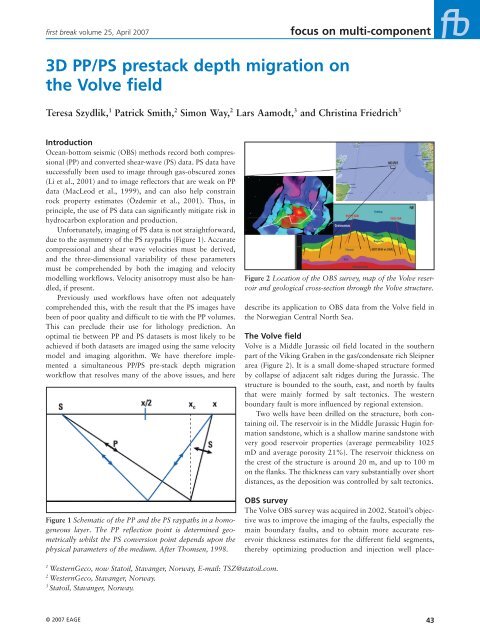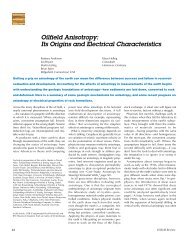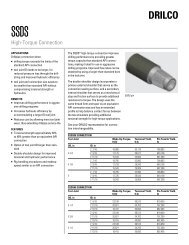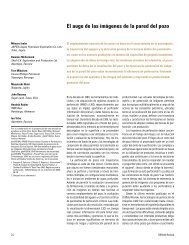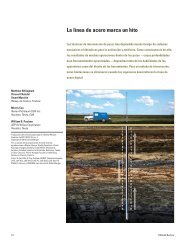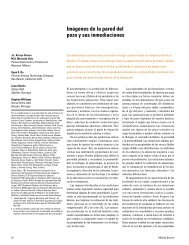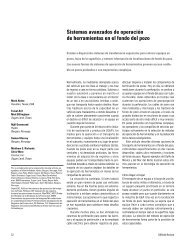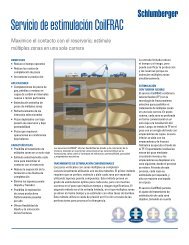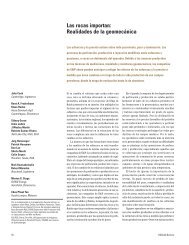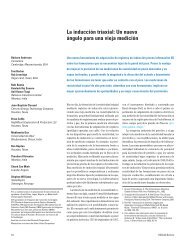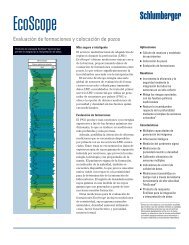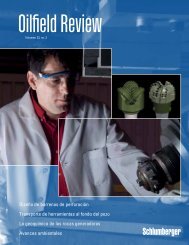D PP/PS prestack depth migration on the Volve field
D PP/PS prestack depth migration on the Volve field
D PP/PS prestack depth migration on the Volve field
Create successful ePaper yourself
Turn your PDF publications into a flip-book with our unique Google optimized e-Paper software.
first break volume 25, April 2007<br />
D <str<strong>on</strong>g>PP</str<strong>on</strong>g>/<str<strong>on</strong>g>PS</str<strong>on</strong>g> <str<strong>on</strong>g>prestack</str<strong>on</strong>g> <str<strong>on</strong>g>depth</str<strong>on</strong>g> <str<strong>on</strong>g>migrati<strong>on</strong></str<strong>on</strong>g> <strong>on</strong><br />
<strong>the</strong> <strong>Volve</strong> <strong>field</strong><br />
Introducti<strong>on</strong><br />
Ocean-bottom seismic (OBS) methods record both compressi<strong>on</strong>al<br />
(<str<strong>on</strong>g>PP</str<strong>on</strong>g>) and c<strong>on</strong>verted shear-wave (<str<strong>on</strong>g>PS</str<strong>on</strong>g>) data. <str<strong>on</strong>g>PS</str<strong>on</strong>g> data have<br />
successfully been used to image through gas-obscured z<strong>on</strong>es<br />
(Li et al., 2001) and to image reflectors that are weak <strong>on</strong> <str<strong>on</strong>g>PP</str<strong>on</strong>g><br />
data (MacLeod et al., 1999), and can also help c<strong>on</strong>strain<br />
rock property estimates (Özdemir et al., 2001). Thus, in<br />
principle, <strong>the</strong> use of <str<strong>on</strong>g>PS</str<strong>on</strong>g> data can significantly mitigate risk in<br />
hydrocarb<strong>on</strong> explorati<strong>on</strong> and producti<strong>on</strong>.<br />
Unfortunately, imaging of <str<strong>on</strong>g>PS</str<strong>on</strong>g> data is not straightforward,<br />
due to <strong>the</strong> asymmetry of <strong>the</strong> <str<strong>on</strong>g>PS</str<strong>on</strong>g> raypaths (Figure 1). Accurate<br />
compressi<strong>on</strong>al and shear wave velocities must be derived,<br />
and <strong>the</strong> three-dimensi<strong>on</strong>al variability of <strong>the</strong>se parameters<br />
must be comprehended by both <strong>the</strong> imaging and velocity<br />
modelling workflows. Velocity anisotropy must also be handled,<br />
if present.<br />
Previously used workflows have often not adequately<br />
comprehended this, with <strong>the</strong> result that <strong>the</strong> <str<strong>on</strong>g>PS</str<strong>on</strong>g> images have<br />
been of poor quality and difficult to tie with <strong>the</strong> <str<strong>on</strong>g>PP</str<strong>on</strong>g> volumes.<br />
This can preclude <strong>the</strong>ir use for lithology predicti<strong>on</strong>. An<br />
optimal tie between <str<strong>on</strong>g>PP</str<strong>on</strong>g> and <str<strong>on</strong>g>PS</str<strong>on</strong>g> datasets is most likely to be<br />
achieved if both datasets are imaged using <strong>the</strong> same velocity<br />
model and imaging algorithm. We have <strong>the</strong>refore implemented<br />
a simultaneous <str<strong>on</strong>g>PP</str<strong>on</strong>g>/<str<strong>on</strong>g>PS</str<strong>on</strong>g> pre-stack <str<strong>on</strong>g>depth</str<strong>on</strong>g> <str<strong>on</strong>g>migrati<strong>on</strong></str<strong>on</strong>g><br />
workflow that resolves many of <strong>the</strong> above issues, and here<br />
© 2007 EAGE<br />
focus <strong>on</strong> multi‑comp<strong>on</strong>ent<br />
Teresa Szydlik, 1 Patrick Smith, 2 Sim<strong>on</strong> Way, 2 Lars Aamodt, 3 and Christina Friedrich 3<br />
Figure 1 Schematic of <strong>the</strong> <str<strong>on</strong>g>PP</str<strong>on</strong>g> and <strong>the</strong> <str<strong>on</strong>g>PS</str<strong>on</strong>g> raypaths in a homogeneous<br />
layer. The <str<strong>on</strong>g>PP</str<strong>on</strong>g> reflecti<strong>on</strong> point is determined geometrically<br />
whilst <strong>the</strong> <str<strong>on</strong>g>PS</str<strong>on</strong>g> c<strong>on</strong>versi<strong>on</strong> point depends up<strong>on</strong> <strong>the</strong><br />
physical parameters of <strong>the</strong> medium. After Thomsen, 1998.<br />
1 WesternGeco, now Statoil, Stavanger, Norway, E-mail: TSZ@statoil.com.<br />
2 WesternGeco, Stavanger, Norway.<br />
3 Statoil, Stavanger, Norway.<br />
Figure 2 Locati<strong>on</strong> of <strong>the</strong> OBS survey, map of <strong>the</strong> <strong>Volve</strong> reservoir<br />
and geological cross-secti<strong>on</strong> through <strong>the</strong> <strong>Volve</strong> structure.<br />
describe its applicati<strong>on</strong> to OBS data from <strong>the</strong> <strong>Volve</strong> <strong>field</strong> in<br />
<strong>the</strong> Norwegian Central North Sea.<br />
The <strong>Volve</strong> <strong>field</strong><br />
<strong>Volve</strong> is a Middle Jurassic oil <strong>field</strong> located in <strong>the</strong> sou<strong>the</strong>rn<br />
part of <strong>the</strong> Viking Graben in <strong>the</strong> gas/c<strong>on</strong>densate rich Sleipner<br />
area (Figure 2). It is a small dome-shaped structure formed<br />
by collapse of adjacent salt ridges during <strong>the</strong> Jurassic. The<br />
structure is bounded to <strong>the</strong> south, east, and north by faults<br />
that were mainly formed by salt tect<strong>on</strong>ics. The western<br />
boundary fault is more influenced by regi<strong>on</strong>al extensi<strong>on</strong>.<br />
Two wells have been drilled <strong>on</strong> <strong>the</strong> structure, both c<strong>on</strong>taining<br />
oil. The reservoir is in <strong>the</strong> Middle Jurassic Hugin formati<strong>on</strong><br />
sandst<strong>on</strong>e, which is a shallow marine sandst<strong>on</strong>e with<br />
very good reservoir properties (average permeability 1025<br />
mD and average porosity 21%). The reservoir thickness <strong>on</strong><br />
<strong>the</strong> crest of <strong>the</strong> structure is around 20 m, and up to 100 m<br />
<strong>on</strong> <strong>the</strong> flanks. The thickness can vary substantially over short<br />
distances, as <strong>the</strong> depositi<strong>on</strong> was c<strong>on</strong>trolled by salt tect<strong>on</strong>ics.<br />
OBS survey<br />
The <strong>Volve</strong> OBS survey was acquired in 2002. Statoil’s objective<br />
was to improve <strong>the</strong> imaging of <strong>the</strong> faults, especially <strong>the</strong><br />
main boundary faults, and to obtain more accurate reservoir<br />
thickness estimates for <strong>the</strong> different <strong>field</strong> segments,<br />
<strong>the</strong>reby optimizing producti<strong>on</strong> and injecti<strong>on</strong> well place-
focus <strong>on</strong> multi‑comp<strong>on</strong>ent first break volume 25, April 2007<br />
Table 1 Seismic processing sequence prior to <str<strong>on</strong>g>depth</str<strong>on</strong>g> imaging.<br />
ment. OBS was chosen over marine streamer acquisiti<strong>on</strong> to<br />
take advantage of improved water-layer multiple attenuati<strong>on</strong> by<br />
combining geoph<strong>on</strong>e and hydroph<strong>on</strong>e measurements, and for<br />
<strong>the</strong> superior illuminati<strong>on</strong> properties given by its wider azimuth<br />
range. The availability of <str<strong>on</strong>g>PS</str<strong>on</strong>g> data was not included in <strong>the</strong> cost<br />
benefit analysis prior to acquisiti<strong>on</strong>, as it was not expected to<br />
c<strong>on</strong>tribute significantly to structural image quality or <strong>the</strong> interpretati<strong>on</strong><br />
of <strong>the</strong> reservoir distributi<strong>on</strong>.<br />
The survey was acquired using an inline shooting geometry.<br />
It comprises six swaths of four-comp<strong>on</strong>ent data, with each<br />
swath comprising data from two 6 km l<strong>on</strong>g Nessie-4C cables<br />
laid <strong>on</strong> <strong>the</strong> seabed with 400 m spacing, and 25 dual source<br />
lines shot with 100 m separati<strong>on</strong>. There was an 800 m moveup<br />
between swaths. The source area covered roughly 70 km 2 and<br />
<strong>the</strong> receiver area about 27 km 2 .<br />
Seismic processing of OBS data<br />
After acquisiti<strong>on</strong>, <strong>the</strong> OBS data was processed through a fairly<br />
standard <str<strong>on</strong>g>PP</str<strong>on</strong>g> pre-stack time imaging flow. At that time a successful<br />
pilot study was performed to dem<strong>on</strong>strate <strong>the</strong> potential<br />
benefits of using a simultaneous <str<strong>on</strong>g>PP</str<strong>on</strong>g>/<str<strong>on</strong>g>PS</str<strong>on</strong>g> pre-stack <str<strong>on</strong>g>depth</str<strong>on</strong>g> imaging<br />
approach, and Statoil <strong>the</strong>refore decided to process <strong>the</strong> full dataset<br />
using this workflow. The project is <strong>the</strong> subject of this paper.<br />
The pre-imaging seismic processing is summarized in Table 1.<br />
Figure 3 The model-building workflow for a single layer of<br />
<strong>the</strong> <str<strong>on</strong>g>depth</str<strong>on</strong>g> model.<br />
Prior to PZ combinati<strong>on</strong>, Z to P comp<strong>on</strong>ent frequency, phase<br />
and amplitude matching was applied. The <str<strong>on</strong>g>PS</str<strong>on</strong>g> dataset was created<br />
by rotati<strong>on</strong> of <strong>the</strong> horiz<strong>on</strong>tal inline and crossline geoph<strong>on</strong>e<br />
comp<strong>on</strong>ents into <strong>the</strong> source-receiver (radial) directi<strong>on</strong> (Gaiser<br />
1999). The pre-processing of <strong>the</strong> <str<strong>on</strong>g>PP</str<strong>on</strong>g> and <strong>the</strong> <str<strong>on</strong>g>PS</str<strong>on</strong>g> data includes<br />
standard wavelet processing, noise and multiple attenuati<strong>on</strong><br />
techniques. This data was input to <strong>the</strong> simultaneous <str<strong>on</strong>g>depth</str<strong>on</strong>g><br />
imaging workflow.<br />
Simultaneous <str<strong>on</strong>g>PP</str<strong>on</strong>g>/<str<strong>on</strong>g>PS</str<strong>on</strong>g> pre‑stack<br />
<str<strong>on</strong>g>depth</str<strong>on</strong>g> imaging workflow<br />
The <str<strong>on</strong>g>PP</str<strong>on</strong>g> and <str<strong>on</strong>g>PS</str<strong>on</strong>g> <str<strong>on</strong>g>depth</str<strong>on</strong>g> imaging is driven by a comm<strong>on</strong> <str<strong>on</strong>g>depth</str<strong>on</strong>g>domain<br />
earth model. This model is layer-based, and each layer<br />
comprises a number of spatially variant attributes:<br />
n Vertical compressi<strong>on</strong>al velocity (Vp) at <strong>the</strong> top of <strong>the</strong> layer<br />
n Vp <str<strong>on</strong>g>depth</str<strong>on</strong>g> gradient<br />
n Vertical shear velocity (Vs) at <strong>the</strong> top of <strong>the</strong> layer<br />
n Vs <str<strong>on</strong>g>depth</str<strong>on</strong>g> gradient<br />
n Thomsens polar anisotropy parameters (epsil<strong>on</strong> and delta)<br />
The velocity model is built using a layer-stripping approach.<br />
Each layer is updated using a combinati<strong>on</strong> of layer-based tomography<br />
and <str<strong>on</strong>g>migrati<strong>on</strong></str<strong>on</strong>g> scanning, c<strong>on</strong>strained by well data such<br />
as compressi<strong>on</strong>al and shear s<strong>on</strong>ic logs, check shot data, etc. For<br />
this particular project, we used spatially invariant anisotropy<br />
parameters and gradients within each layer.<br />
On <strong>the</strong> <strong>Volve</strong> project, compressi<strong>on</strong>al s<strong>on</strong>ic log and check<br />
shot data were available for five wells. We also had shear s<strong>on</strong>ic<br />
log data for two wells, but chose not to use this for velocity<br />
modelling, as we were uncertain about <strong>the</strong>ir accuracy. The<br />
layer boundaries, chosen by examining <strong>the</strong> s<strong>on</strong>ic logs and initial<br />
velocity analyses made from <strong>the</strong> seismic data, defined <strong>the</strong> major<br />
interval velocity c<strong>on</strong>trasts and changes in velocity gradient.<br />
The velocity modelling workflow for a given layer is shown<br />
in Figure 3. The model is first flooded from <strong>the</strong> top of <strong>the</strong><br />
current layer downwards with an initial estimate of Vp. The<br />
epsil<strong>on</strong> and delta values are initially set to zero for <strong>the</strong> shallow<br />
layers, but for <strong>the</strong> deeper layers, initial estimates are used, based<br />
Figure 4 The Vp/Vs ratio derived from <strong>the</strong> <strong>Volve</strong> <str<strong>on</strong>g>depth</str<strong>on</strong>g> model<br />
(left) compared with <strong>the</strong> high-resoluti<strong>on</strong> Vp/Vs ratio derived<br />
using <strong>the</strong> method of Nickel et al. (2004).<br />
© 2007 EAGE
first break volume 25, April 2007<br />
© 2007 EAGE<br />
focus <strong>on</strong> multi‑comp<strong>on</strong>ent<br />
Figure 5 Vertical slices through <strong>the</strong> <str<strong>on</strong>g>depth</str<strong>on</strong>g> model showing colour-coded Vp and Vs properties. For each layer listed are velocity<br />
gradients dv/dz [m/s/m] and Thomsen anisotropy parameters delta and epsil<strong>on</strong>.<br />
Figure 6 Figure 6 shows, for well A, <strong>the</strong> s<strong>on</strong>ic log velocities, Vp extracted from <strong>the</strong> velocity model at <strong>the</strong> well locati<strong>on</strong>, and<br />
<str<strong>on</strong>g>depth</str<strong>on</strong>g> migrated <str<strong>on</strong>g>PP</str<strong>on</strong>g> and <str<strong>on</strong>g>PS</str<strong>on</strong>g> data as a composite seismic secti<strong>on</strong> crossing <strong>the</strong> well locati<strong>on</strong>.
focus <strong>on</strong> multi‑comp<strong>on</strong>ent first break volume 25, April 2007<br />
<strong>on</strong> <strong>the</strong> layers above. The <str<strong>on</strong>g>PP</str<strong>on</strong>g> data is <strong>the</strong>n migrated. We evaluate<br />
<strong>the</strong> flatness of <strong>the</strong> resulting comm<strong>on</strong> image point (CIP)<br />
ga<strong>the</strong>rs, and <strong>the</strong> <str<strong>on</strong>g>depth</str<strong>on</strong>g> tie between <strong>the</strong> seismic and well data.<br />
Vp, epsil<strong>on</strong>, and delta are updated as necessary and a sec<strong>on</strong>d<br />
<str<strong>on</strong>g>migrati<strong>on</strong></str<strong>on</strong>g> performed. The process is repeated until we are<br />
happy with <strong>the</strong> ga<strong>the</strong>r flatness and <str<strong>on</strong>g>depth</str<strong>on</strong>g> tie with <strong>the</strong> wells.<br />
We <strong>the</strong>n generate Vs for <strong>the</strong> current layer, usually by assuming<br />
a Vp/Vs ratio based <strong>on</strong> well data or o<strong>the</strong>r informati<strong>on</strong>, and<br />
migrate <strong>the</strong> <str<strong>on</strong>g>PS</str<strong>on</strong>g> data. Vs is updated to achieve a zero-offset<br />
<str<strong>on</strong>g>depth</str<strong>on</strong>g> tie with <strong>the</strong> migrated <str<strong>on</strong>g>PP</str<strong>on</strong>g> data, and to <strong>the</strong> wells. The data<br />
are remigrated and <strong>the</strong> process repeated until we are happy<br />
with <strong>the</strong> <str<strong>on</strong>g>depth</str<strong>on</strong>g> ties. We <strong>the</strong>n evaluate <strong>the</strong> flatness of <strong>the</strong> <str<strong>on</strong>g>PS</str<strong>on</strong>g><br />
CIP ga<strong>the</strong>rs, and update <strong>the</strong> anisotropy parameters, iterating<br />
as necessary. Next we remigrate <strong>the</strong> <str<strong>on</strong>g>PP</str<strong>on</strong>g> data with <strong>the</strong> revised<br />
anisotropy parameters to ensure that <strong>the</strong> <str<strong>on</strong>g>PP</str<strong>on</strong>g> ga<strong>the</strong>rs are<br />
optimally flattened. Because <strong>the</strong> <str<strong>on</strong>g>PP</str<strong>on</strong>g> data are less sensitive to<br />
anisotropy than <str<strong>on</strong>g>PS</str<strong>on</strong>g>, <strong>the</strong> anisotropy parameters which flatten<br />
<strong>the</strong> <str<strong>on</strong>g>PS</str<strong>on</strong>g> ga<strong>the</strong>rs are normally also appropriate for <strong>the</strong> <str<strong>on</strong>g>PP</str<strong>on</strong>g> data.<br />
We can <strong>the</strong>n move <strong>on</strong> to <strong>the</strong> next layer.<br />
Seven layers were sufficient to represent <strong>the</strong> subsurface<br />
down to Middle Jurassic. Optimizati<strong>on</strong> of each layer prop-<br />
Figure 7 Modelled versus measured Vp and Vs in well B.<br />
6<br />
erty required up to three <str<strong>on</strong>g>depth</str<strong>on</strong>g> <str<strong>on</strong>g>migrati<strong>on</strong></str<strong>on</strong>g> iterati<strong>on</strong>s.<br />
It is obviously vital that <strong>the</strong> same reflecti<strong>on</strong> is interpreted<br />
<strong>on</strong> both <strong>the</strong> <str<strong>on</strong>g>PP</str<strong>on</strong>g> and <str<strong>on</strong>g>PS</str<strong>on</strong>g> data, something that is not always<br />
straightforward. Our top-down method means that <strong>the</strong> <str<strong>on</strong>g>PS</str<strong>on</strong>g><br />
data for <strong>the</strong> next iterati<strong>on</strong> can be quite accurately imaged<br />
using <strong>the</strong> current model and an assumed Vp/Vs ratio for<br />
<strong>the</strong> next layer, which greatly eases correlati<strong>on</strong> of <str<strong>on</strong>g>PP</str<strong>on</strong>g> and <str<strong>on</strong>g>PS</str<strong>on</strong>g><br />
reflectors. It can also be helpful to use <str<strong>on</strong>g>PP</str<strong>on</strong>g> and <str<strong>on</strong>g>PS</str<strong>on</strong>g> syn<strong>the</strong>tic<br />
seismograms, based <strong>on</strong> well data, to evaluate <strong>the</strong> expected<br />
difference in phase and amplitude character of a given reflector<br />
<strong>on</strong> <strong>the</strong> two datasets.<br />
The <str<strong>on</strong>g>depth</str<strong>on</strong>g> imaging workflow ensures that <strong>the</strong> <str<strong>on</strong>g>PP</str<strong>on</strong>g> and <str<strong>on</strong>g>PS</str<strong>on</strong>g><br />
data match at <strong>the</strong> velocity model layer boundaries, but does<br />
not guarantee a tie in between. The automated <str<strong>on</strong>g>PS</str<strong>on</strong>g> to <str<strong>on</strong>g>PP</str<strong>on</strong>g> event<br />
registrati<strong>on</strong> and matching algorithm developed by Nickel et al.<br />
(2004) can be used to align <strong>the</strong> datasets in a high frequency<br />
manner, generating, as a by-product, a high resoluti<strong>on</strong> Vp/Vs<br />
ratio cube (Figure 4) that is also a valuable interpretati<strong>on</strong><br />
attribute. The alignment assures c<strong>on</strong>sistency between attributes<br />
extracted from <strong>the</strong> <str<strong>on</strong>g>PP</str<strong>on</strong>g> and <str<strong>on</strong>g>PS</str<strong>on</strong>g> cubes, and is a prerequisite for<br />
simultaneous pre-stack inversi<strong>on</strong>.<br />
Figure 8 Comparis<strong>on</strong> of <strong>the</strong> <str<strong>on</strong>g>PP</str<strong>on</strong>g> dataset after <str<strong>on</strong>g>prestack</str<strong>on</strong>g> time<br />
<str<strong>on</strong>g>migrati<strong>on</strong></str<strong>on</strong>g> and <str<strong>on</strong>g>prestack</str<strong>on</strong>g> <str<strong>on</strong>g>depth</str<strong>on</strong>g> <str<strong>on</strong>g>migrati<strong>on</strong></str<strong>on</strong>g>. Note improvement<br />
in <strong>the</strong> fault definiti<strong>on</strong> <strong>on</strong> <strong>the</strong> <str<strong>on</strong>g>prestack</str<strong>on</strong>g> <str<strong>on</strong>g>depth</str<strong>on</strong>g>-migrated dataset<br />
(a). Time slices showing better reservoir image after <str<strong>on</strong>g>prestack</str<strong>on</strong>g><br />
<str<strong>on</strong>g>depth</str<strong>on</strong>g> <str<strong>on</strong>g>migrati<strong>on</strong></str<strong>on</strong>g> (b).<br />
A<br />
B<br />
© 2007 EAGE
first break volume 25, April 2007<br />
Simultaneous <str<strong>on</strong>g>PP</str<strong>on</strong>g>/<str<strong>on</strong>g>PS</str<strong>on</strong>g> pre‑stack <str<strong>on</strong>g>depth</str<strong>on</strong>g> imaging results<br />
Figure 5 shows vertical slices through <strong>the</strong> final model, colourcoded<br />
by Vp and Vs. Epsil<strong>on</strong> and delta are listed for each layer.<br />
It is obvious that <strong>the</strong> Vp/Vs ratio varies spatially and with<br />
<str<strong>on</strong>g>depth</str<strong>on</strong>g>.<br />
Figure 6 shows <strong>the</strong> s<strong>on</strong>ic log velocities for well A, Vp<br />
extracted from <strong>the</strong> velocity model at <strong>the</strong> well locati<strong>on</strong>, and<br />
<str<strong>on</strong>g>depth</str<strong>on</strong>g>-migrated <str<strong>on</strong>g>PP</str<strong>on</strong>g> and <str<strong>on</strong>g>PS</str<strong>on</strong>g> data as a composite seismic secti<strong>on</strong><br />
crossing <strong>the</strong> well positi<strong>on</strong>. The <str<strong>on</strong>g>PP</str<strong>on</strong>g> seismic ties <strong>the</strong> <str<strong>on</strong>g>depth</str<strong>on</strong>g> markers<br />
at <strong>the</strong> well locati<strong>on</strong>, and <strong>the</strong> Vp profile agrees well with <strong>the</strong><br />
s<strong>on</strong>ic velocities. By enforcing a <str<strong>on</strong>g>depth</str<strong>on</strong>g> tie between <str<strong>on</strong>g>PP</str<strong>on</strong>g> and <str<strong>on</strong>g>PS</str<strong>on</strong>g><br />
during velocity model building, we implicitly achieve a <str<strong>on</strong>g>depth</str<strong>on</strong>g><br />
tie between <str<strong>on</strong>g>PS</str<strong>on</strong>g> and <strong>the</strong> wells.<br />
Figure 7 shows compressi<strong>on</strong>al and shear s<strong>on</strong>ic logs from<br />
well B, overlain by Vp and Vs extracted from <strong>the</strong> final velocity<br />
model at <strong>the</strong> well locati<strong>on</strong>. We see an excellent tie, even though<br />
<strong>the</strong> shear s<strong>on</strong>ic logs were not used during modelling.<br />
Comparis<strong>on</strong> of <str<strong>on</strong>g>PP</str<strong>on</strong>g> pre-stack time and pre-stack <str<strong>on</strong>g>depth</str<strong>on</strong>g><br />
migrated datasets shows that <strong>the</strong> pre-stack <str<strong>on</strong>g>depth</str<strong>on</strong>g> <str<strong>on</strong>g>migrati<strong>on</strong></str<strong>on</strong>g> better<br />
images <strong>the</strong> subtle faulting that is characteristic of this area<br />
(Figure 8(a)) and reservoir structure (Figure 8(b)). However <strong>the</strong><br />
real value of <strong>the</strong> approach is seen when <strong>the</strong> <str<strong>on</strong>g>PP</str<strong>on</strong>g> and <str<strong>on</strong>g>PS</str<strong>on</strong>g> <str<strong>on</strong>g>depth</str<strong>on</strong>g><br />
migrated datasets are compared (Figure 9). The correlati<strong>on</strong> of<br />
reflecti<strong>on</strong>s between <strong>the</strong> two datasets is unambiguous over much<br />
of <strong>the</strong> secti<strong>on</strong>. We see differences in character between some<br />
reflecti<strong>on</strong>s. The <str<strong>on</strong>g>PS</str<strong>on</strong>g> and <str<strong>on</strong>g>PP</str<strong>on</strong>g> CIP ga<strong>the</strong>rs (Figure 10) show similar<br />
differences, which are not related to poor imaging, but are<br />
indicative of genuine differences in <str<strong>on</strong>g>PP</str<strong>on</strong>g> and <str<strong>on</strong>g>PS</str<strong>on</strong>g> reflectivity, and<br />
which presumably carry informati<strong>on</strong> about rock properties.<br />
The interpretability of <strong>the</strong> <str<strong>on</strong>g>PS</str<strong>on</strong>g> data below <strong>the</strong> Base Cretaceous<br />
unc<strong>on</strong>formity still does not match that of <strong>the</strong> <str<strong>on</strong>g>PP</str<strong>on</strong>g> cube (Figure 9).<br />
This is perhaps unsurprising; <strong>the</strong> shear impedance c<strong>on</strong>trast of<br />
<strong>the</strong> reservoir interval is quite small and <strong>the</strong> reservoir structure<br />
is complex. <str<strong>on</strong>g>PS</str<strong>on</strong>g> imaging is much more reliant <strong>on</strong> <strong>the</strong> accuracy of<br />
<strong>the</strong> velocity model than <str<strong>on</strong>g>PP</str<strong>on</strong>g> imaging, and so small inaccuracies<br />
in <strong>the</strong> model affect <strong>the</strong> <str<strong>on</strong>g>PS</str<strong>on</strong>g> data to a greater extent.<br />
C<strong>on</strong>clusi<strong>on</strong>s<br />
The <str<strong>on</strong>g>depth</str<strong>on</strong>g> imaging workflow presented here has been used<br />
successfully <strong>on</strong> a number of projects. Applicati<strong>on</strong> to <strong>the</strong> <strong>Volve</strong><br />
OBS data gives a <str<strong>on</strong>g>PS</str<strong>on</strong>g> dataset that unambiguously ties <strong>the</strong> <str<strong>on</strong>g>PP</str<strong>on</strong>g><br />
dataset in <str<strong>on</strong>g>depth</str<strong>on</strong>g> and character down to BCU level. This was<br />
achieved by determining an accurate polar anisotropic compressi<strong>on</strong>al<br />
and shear velocity model of <strong>the</strong> subsurface using all<br />
available data.<br />
Currently many OBS acquisiti<strong>on</strong>s are justified solely <strong>on</strong><br />
<strong>the</strong> likelihood of improved <str<strong>on</strong>g>PP</str<strong>on</strong>g> data quality. We believe that <strong>the</strong><br />
workflow presented will help fur<strong>the</strong>r extend <strong>the</strong> applicability<br />
of OBS data to lithology and fluid predicti<strong>on</strong>, and that <strong>the</strong><br />
availability of <str<strong>on</strong>g>PS</str<strong>on</strong>g> data should be weighted more heavily when<br />
seismic data acquisiti<strong>on</strong> decisi<strong>on</strong>s are being made.<br />
References<br />
Xiang-Yang Li, Hengchang Dai, Mueller, M.C., and Barkved,<br />
O.I. [2001] Compensating for <strong>the</strong> effects of gas clouds <strong>on</strong> C-<br />
focus <strong>on</strong> multi‑comp<strong>on</strong>ent<br />
Figure 9 Comparis<strong>on</strong> of <strong>the</strong> <str<strong>on</strong>g>PP</str<strong>on</strong>g> and <str<strong>on</strong>g>PS</str<strong>on</strong>g> <str<strong>on</strong>g>depth</str<strong>on</strong>g>-migrated results<br />
in <str<strong>on</strong>g>depth</str<strong>on</strong>g>.<br />
Figure 10 Comparis<strong>on</strong> of CIP <str<strong>on</strong>g>depth</str<strong>on</strong>g> ga<strong>the</strong>rs from <strong>the</strong> <str<strong>on</strong>g>PP</str<strong>on</strong>g> and<br />
<str<strong>on</strong>g>PS</str<strong>on</strong>g> datasets.<br />
wave imaging: A case study from Valhall. The Leading Edge,<br />
20, 1022.<br />
Gaiser, J.E. [1999] Applicati<strong>on</strong>s for vector coordinate systems of<br />
3-D c<strong>on</strong>verted-wave data. The Leading Edge, 18, 1290-1300.<br />
MacLeod, M., Hans<strong>on</strong>, R., Hadley, M., Reynolds, K., Lumley,<br />
D., McHugo, S., and Probert, T. [1999] The Alba Field<br />
OBC seismic survey. 69 th SEG Annual Internati<strong>on</strong>al Meeting,<br />
Expanded Abstract, 18, 725.<br />
Nickel, M. and S<strong>on</strong>neland, L. [2004] Automated <str<strong>on</strong>g>PS</str<strong>on</strong>g> to <str<strong>on</strong>g>PP</str<strong>on</strong>g> event<br />
registrati<strong>on</strong> and estimati<strong>on</strong> of a high-resoluti<strong>on</strong> Vp-Vs ratio<br />
volume. 74 th SEG Annual Internati<strong>on</strong>al Meeting, Expanded<br />
Abstract, 23, 869.<br />
Thomsen, L. [1998] C<strong>on</strong>verted-wave reflecti<strong>on</strong> seismology<br />
over anisotropic, inhomogenous media. 68 th SEG Annual<br />
Internati<strong>on</strong>al Meeting, , Extended Abstracts, 2048-2051.<br />
Özdemir, H., R<strong>on</strong>en, S., Olofss<strong>on</strong>, B., Goodway, B., and Young,<br />
P. [2001] Simultaneous multicomp<strong>on</strong>ent AVO inversi<strong>on</strong>. 71 st<br />
SEG Annual Internati<strong>on</strong>al Meeting, Expanded Abstract, 20,<br />
269.<br />
© 2007 EAGE 7


